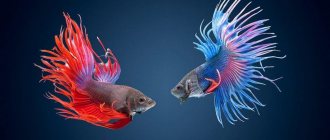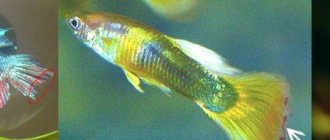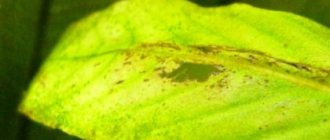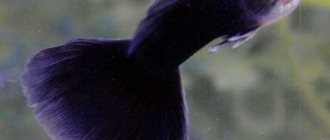Trichodinosis
Infection with trichodinosis occurs through a parasite - the ciliate Trichodina modestus. Most often, parasites develop in fry and young individuals, since their bodies are quite weak. Fish can also become infected with trichodinosis from healthy fish.
At the initial stage of the disease, the fish seem to be itching against the plants in the aquarium; some fish have dull spots on their bodies.
You can get rid of ciliates by raising the temperature of the water in the aquarium to 34 °C, while very strong aeration of the water is necessary so that the fish have enough oxygen at such a high temperature. Adding the following components to water will be no less effective:
- sea or table salt;
- tripavlavina;
- methyl blue.
See what a guppy infected with Columnaria looks like.
Adviсe
- Before you buy new fish, find out what species they are, their environment, and whether they are compatible with guppies.
- A spare aquarium is required for quarantine of new fish, treatment and spawning.
- If you notice something strange in the behavior and appearance of fish in a pet store, refuse to purchase.
- If it is necessary to improve the conditions of water inhabitants, do it gradually. Any sudden changes in the aquatic environment are a source of stress for pets.
- Fish are more comfortable in a rectangular tank rather than a round one.
Advice and treatment methods vary greatly from one source to another. Sometimes sellers in pet stores give harmful recommendations. Consult with experienced aquarists and veterinarians and check the information carefully.
Previous
Diseases10 types of algae and how to combat them in the aquarium
Next
DiseasesHow to get rid of black beard in an aquarium?
Plistophorosis
Plistophora is one of the most dangerous diseases of aquarium guppy fish, which is transmitted from mother to fry. Recognizing the disease is quite simple: the fish become pale and stop eating, which leads to great exhaustion. The body position of the fish changes: the tail goes down, and the body is at an angle of 45-60 ° C, while the fish make jerking movements.
The parasite lives in the muscle tissue of fish, so the body of the infected fish becomes deformed and movements become spasmodic.
In case of fish disease with plistophora blight, all fish should be immediately destroyed , the soil should be boiled, and plants and equipment should be thoroughly disinfected.
Diseases of aquarium fish guppy: how to identify and cure them
How wonderful the aquarium looks in the interior! Fish are creatures that can relax and distract from problems. However, they also require special care. And like all living beings, fish can get sick. Let's find out what diseases aquarium fish guppies can get.
January 22, 2014
Author: Zvyashchenko Ulyana
If we compare guppies with other aquarium inhabitants, we can safely say that these are the most disease-resistant fish, however, some diseases can lead to a serious condition and sometimes even death of the fish. That is why every owner of these fish should know what diseases of aquarium guppy fish exist.
Red scab and split fin
The disease occurs only in male guppies. A red coating appears on the tail of the male, which can “eat” the entire tail of the fish if the infected part is not removed in time. To cut it, use a very sharp razor. The fish can only be saved if no more than 1/3 of the fin is damaged. Then salt is added to the water (2-3 g per liter).
General symptoms
Each disease has its own characteristic signs by which it can be identified. But besides this, there are general symptoms that indicate health problems in guppies:
- Apathy or, conversely, hyperactivity;
- Loss of appetite or overeating;
- Change in color of scales or fins;
- Bloating;
- Peeling of scales;
- Deterioration of coordination;
- Sudden aggression;
- The appearance of bruises on the body;
- Dramatic weight loss;
- Change in habitat level (guppies swim on the surface, although they have never done this before, or vice versa).
The presence of at least one of these symptoms is a sign that the fish has health problems. Therefore, after its detection, you need to carefully monitor the animal in order to make a diagnosis and carry out further treatment.
Fin rot
Fin rot is a disease of aquarium guppy fish that occurs in females and is expressed in the disintegration of interradial tissue. Treatment is carried out in a common aquarium. The drugs are selected from the following:
- bicillin 5;
- biomycin;
- white streptocid.
Depending on the choice of drug, treatment takes from 1 to 3 months.
To prevent all kinds of fish diseases, you need to very carefully monitor the cleanliness of the aquarium and take care of it in a timely manner. Also, after acquiring new fish, you should not immediately put them into the general aquarium. It is advisable to keep them in a separate container for several days to observe their behavior. This way you can prevent the introduction of a new disease into the aquarium.
- Guppy infertility. Female guppies become unable to give birth to fry. The color of the fish fades, especially shades of red disappear in the color. This is due, first of all, to prolonged over-lighting in the aquarium. “Daylight” for guppies takes no more than 10-12 hours a day. By adjusting the lighting in the aquarium, the owner can hope that bright colors will return to the fish, but infertility, alas, is incurable.
- Poor growth of males. It happens that fry, especially male guppies, grow poorly, do not reach their full “adult” size, and their color becomes faded. This is due to the fact that during the period of intensive growth they are in an aquarium with poor aeration. Before maturity, the situation can be partially corrected by adjusting the water supply in the aquarium.
- Hermaphroditism. A phenomenon in which females develop a testis, a male organ, along with the ovary. There may be cases of self-fertilization of such fish. The overwhelming percentage of offspring, as a rule, have the same “bisexual” characteristics. And a small number of males are born sterile. The phenomenon and its causes have been little studied.
- Dropsy (ascites). Dropsy is an intestinal disease. The main symptoms that characterize dropsy are a swollen abdomen and ruffled scales. The fish tries to go down and hide. Dropsy also causes bulging eyes. Dropsy is a viral disease that can be treated with antibacterial drugs and frequent water changes.
- Tetrachymenosis is a specific disease of guppy that is rarely found in other fish. The causative agents are tetrahymena, small ciliated ciliates. Tetrahymena feed on both microorganisms and tissues of multicellular creatures, which invariably entails the possibility of infection. Tetrahymena infects the most vulnerable parts of guppies - the slimy gills and fins. On the surface of the body of a fish that has been struck by tetrahymena, a white mucous coating is clearly visible, which then slides off in flakes, the scales become ruffled and the gills protrude.
- Later, tetrahymena penetrate deeper into the “host’s” body and begin to devour it from the inside. At this stage, patients may experience bloating. Tetrahymena fry can be eaten almost completely. Tetrahymena are destroyed by furazolidone and biseptol, which are dissolved in water. The drugs are harmful to plants, so it is better to treat them in a nursery. Tetrahymena are dangerous not only for guppies, but also for their neighbors - for example, labyrinth fish. Therefore, healthy pets are recommended to undergo prophylaxis by adding furazolidone to their food.
- Scoliosis or curvature of the spine. The disease occurs in guppy fry and is a curvature of the fish’s spine, its smaller size, and a retracted abdomen. This is a congenital defect that presumably occurs due to insufficient aeration of the aquarium in which the pregnant female is kept and inadequate nutrition. Spinal curvature cannot be treated. A spine bent by disease remains that way forever. As a rule, fish with a curved spine are smaller and weaker than their peers, and are more susceptible to infections. Guppies with deformities are discarded from selection.
- Ichthyophthirius multiphyliis or guppy disease. Characteristic specifically for this type of fish. Affects the body, stomach, and gills of guuppies. In the early stages, the fish show signs of itching, then whitish rashes appear on the surface of the body. The rash increases over several days. When the rash affects the gills, respiratory function is impaired. Lethargy, apathy, and loss of appetite also appear. The fish may tend to go down, closer to the bottom. Scales rise on the surface of the body. It is treated with specialized medications or formaldehyde baths. In the case of formaldehyde treatment, it is important to use a fresh solution each time - “old” is poisonous to fish.
Incurable diseases
A diligent fish farmer will read - conditionally incurable or currently incurable. Maybe you will find a way to save your pets from the ailments listed below, then be sure to let us know!
Fish tuberculosis or mycobacteriosis
Symptoms: loss of appetite and rapid weight loss. Intracted belly and hunched back. Dull body color, black eyes and strange behavior - the guppy hides at the bottom, becomes apathetic, lethargic. The luxurious tail hangs, sometimes vertical swimming is observed. All these are symptoms of a terrible disease - mycobacteriosis, or simply fish tuberculosis.
Fish tuberculosis is highly contagious!
Causes: infection.
This disease cannot be treated . There are either rumors or legends circulating within the aquarium community that someone was lucky enough to defeat fish tuberculosis by mixing antibiotics into the food, but there is no scientific evidence of this. In addition, one of the main signs of tuberculosis is refusal to eat…. Well, decide for yourself how true the rumors are!
However, if such symptoms are detected, it is still necessary to take action, and immediately!
- Place the sick individual in a separate container;
- Disinfect the aquarium, soil, decorations;
- If possible, get rid of plants or thoroughly clean them;
- Carefully observe the rest of the population of the aquarium and, if the slightest suspicion appears, remove a possible patient and repeat steps 1-3.
Plistophorosis
Symptoms: Vertical swimming (the head looks up, the tail is down), when trying to take the natural position of the body, an upward jump occurs, the color turns pale, appetite is lost, up to a complete refusal of food, the stomach becomes sunken.
Causes: plystophorosis in guppies is inherited. This is a very rare disease.
Plystophorosis cannot be treated . All you have to do is destroy the sick guppy and start cleaning the aquarium: rinse it and the decor, boil the soil.
First aid
Not all diseases of aquarium fish are curable. There is no universal method to help with those ailments that can be treated. However, any aquarist should know a number of initial measures to help a sick fish.
- It is best to remove a sick fish from the general aquarium in order to carry out treatment. This way she won’t infect others, and it will be more convenient to treat her.
- When preparing a fish tank (for guppies, a regular jar with a capacity of 2 liters or more is enough), use water from a common container, mixing it with fresh water.
- The water in the reservoir is changed daily. Aeration is not necessary.
- The water should be salted - 1 gram per liter, and add a few drops of iodine. When changing the water, the concentration of nutrients should be restored.
- It is best to feed a sick pet with live food - it is more nutritious and will allow her to recover faster. Bloodworms are perfect.
- The volume of water in the hatchery is very small, it spoils easily, so feed carefully and immediately remove uneaten food debris.
- Such measures are only first aid; then, having accurately identified the disease, more serious treatment can begin. However, in cases that are not too severe, the first measures can help.
DISEASES OF AQUARIUM FISH, CONTAGIOUS AND NON-CONTAGIOUS - TREATMENT DESCRIPTION PHOTO SYMPTOMS VIDEO.
Diseases of aquarium fish guppy
Sometimes females develop scoliosis after giving birth to guppy fry.
, which is apparently associated with a sharp change in intra-abdominal pressure.
Fin rot is quite common in scarf guppies, especially females.
: disintegration of interradial tissue.
This guppy disease is treated in a community aquarium using bicillin-5, malachite green with copper sulfate, biomycin (the course of treatment lasts 1.5-2 months or more), white streptocide (10-20 grams per 100 liters of water for 2-3 months); in a separate vessel, basic violet K, malachite green, and bicillin-5 are used. In males of veiled forms, especially fan-tailed ones, see photo of guppies
, a frayed caudal fin is often observed. The edge of the fin can be trimmed with a sharp razor, covering the gill covers of the male with cotton wool soaked in water. After such an operation, the tail will grow back, but its end will be unnaturally smooth, and the regenerated part will be pale in color. Less commonly, male guppies experience compression of their fins. The reason, apparently, is monotonous feeding after they reach puberty, unsatisfactory and unstable living conditions. For treatment, you can use sea or table salt (1-2 g/l).
A disease called red scab
, in which a bright red plaque appears at the end of the caudal fin, gradually eating up the entire tail. The affected part should be cut off with a sharp razor, and salt (2.5 g/l) should be added to the water. This disease can also be treated with chloramphenicol (80 mg/l, exposure 24 hours). A real scourge for guppies is the longitudinal splitting of the fin, the so-called split, which is quite often observed in veiled males. The split is most noticeable in black red-tailed and carpet males. The etiology of this guppy disease is unknown; Possibly genetically determined.
Hermaphroditism has been repeatedly observed in female guppies.
: along with the ovary they also had a testis. As a result of self-fertilization, offspring were born in which 97% of the individuals were females (and also hermaphrodites, who in turn gave birth to female offspring), and few males had chromosomes characteristic of females. Most of these males, which are genetically female, are sterile. Single individuals in which testes develop, when crossed with normal females, produce only female offspring. Often, in guppies, like most swordtails and some other species, there are cases of spontaneous transformation of females (even those that have already spawned) into males. Such “redefined” males (genetically they are females) can have significantly larger sizes than normal ones. Much less common are cases of spontaneous transformation of males into females.
COMMENTS ON THE TOPIC
INTERESTING TO READ
Parasitic diseases of fish
Parasitic diseases of fish can be caused by plants and animals. Parasites settle on any organs of fish, but most often on the gills, skin and in the gastrointestinal tract.
Many parasites cause irritation and sometimes mechanical damage to the body. Products…
Healing lotions
If parasites have deeply penetrated the skin and adjacent tissues, and treatment in a general aquarium and with medicinal baths does not give the desired effect, medicinal lotions with a cotton swab moistened with highly concentrated medications can help. For lotions...
The fish swims strangely
It is very important to know what behavior is typical for a given species. For example, nocturnal fish may look lethargic during the day and vice versa. Some fish species rarely show activity at all! Fish recently introduced into the aquarium are usually inactive...
Fish disease identification table
The table mainly covers the most common fish diseases. When using it, you need to keep in mind that you can correctly identify a disease in cases where it is caused by a single cause. There are cases when the infection (ichthyophonus) did not initially cause external ...
Subscribe to zoonews
Yes, aquarium fish sometimes get sick too. Let's talk about one of the most dangerous diseases - plistophora. There is another, more well-known name - neon disease .
What are the signs (symptoms) of plistophorosis? When neon disease appears in erythrozonus, lanternflies, zebrafish and neons, the bright stripe in the middle of their body becomes slightly dull, and the overall color of the aquarium fish becomes less saturated.
A little later, when neon disease begins to progress, other symptoms appear. If you observe a sick fish, you will notice that the coordination of its movements is impaired: an aquarium fish infected with plistophora begins to swim with its tail down (at an angle of approximately 50-600).
She does not sleep at night, eats much less and is constantly moving. on the body of an individual suffering from neon disease , which gradually cover the entire body.
Basically, plistophora disease affects aquarium fish of the characin species, but sometimes neon disease can also occur in guppies. As sad as it is to say, but, most often, fish infected with plistophorosis die after a while.
How to treat an aquarium fish with neon disease ?
Strange behavior, what causes it
The strange behavior of guppies is almost always caused by various diseases. If the fish swims on its side, this is a cause for concern, since this is a symptom of a dangerous disease - glucose disease. Other signs include swelling of the eye or bulging eyes appearing on only one side. The cause of the disease is parasites that multiply quickly and affect the liver, stomach, eyes, and gills. Glugosis is an incurable disease and all guppies die. If the diagnosis is confirmed, all contents of the aquarium are destroyed and the tank is disinfected.
To avoid infection of all fish, new individuals need to be kept in quarantine and only after making sure that the pet is not sick, it is transplanted into a common container.
If a guppy swims with its belly up, there can be many reasons, here are the most common:
- Helminthic infestations.
- Viral or infectious diseases.
- General weakness.
- Oncological or fungal diseases.
- Severe gas formation in the intestines.
- Swim bladder diseases.
- Poor nutrition.
The cause is usually considered to be an inflammatory process in the bladder - this is a contagious disease caused by pathogenic microorganisms. Infection occurs due to poor quality food or water.
If treatment of the disease is started at the first stage, the prognosis is positive. During treatment, the fish should be left without food, this will stop the inflammation.
The lifespan of the fish also influences behavior. Determining the age of a guppy is difficult, but if you are careful, you can see the difference. Young fish have a simple body shape. Growing up pets have a more convex belly, a slight arch on the back, which increases with aging. Guppies up to six months have a fiery disposition and although they have color, the tail is still at the development stage. Adult fish are calmer, after 1 year the color is at its peak.
Prevention
Almost all guppy diseases are the result of violation of fish keeping standards. In order for animals to remain healthy for a long time, you should follow some simple but important rules:
- Buy fish food only in special stores, and not bring it yourself from natural reservoirs;
- If a sick fish is identified, immediately place it in a separate aquarium, and in the main body of water, disinfect the decorations and walls;
- Do not overfeed the inhabitants;
- Choose your neighborhood wisely, excluding cases of hostility;
- Maintain the required water parameters;
- Do not overpopulate the aquarium.
Although guppies have strong immunity, it is important to closely monitor their health. After all, these fish are prone to some specific diseases that are difficult to treat. But the attention and love of the owner can protect the fish from any disease.
Back problems
Curvature of the spine is common among guppies. This pathology can be either acquired or congenital. In the first case, you can fight it, in the second, you can’t.
There are two types of spinal curvature:
- Downward curvature;
- Curvature to the side.
If the spine bent down suddenly, not from birth, then the fish’s nutrition should be adjusted and given less food.
There are several reasons for acquired sideways curvature of the spine:
- Overpopulation of the aquarium;
- Infection with infectious diseases;
- Increased water hardness.
If the guppies do not show other signs of infection with a dangerous disease, then the number of fish in the aquarium should be reconsidered or the water hardness should be corrected. Otherwise, the sick animal should be temporarily quarantined in a separate container and closely monitored.
Congenital curvature of the spine
Scoliosis, which manifests itself in juveniles, cannot be treated. Individuals with this disease are often weaker than their brothers and sisters and are more susceptible to various infections.
The reason for the birth of fry with back problems is insufficient aeration of the reservoir where the pregnant female was and her unbalanced diet, which contains little protein.
Scoliosis or curvature of the spine
Scoliosis of the back in guuppies can occur for many reasons. To prescribe competent treatment, it is necessary to correctly determine the nature of the deviation:
- The spine curved downward. This may indicate that your pet is overeating and his back cannot withstand the constant load and sinks down under the weight of excess food. Try to reduce food portions and make sure that the guppy does not take food from smaller and weaker relatives.
- The spine was bent to the side. This can happen to both juveniles and adults. There may be several reasons: overcrowding of inhabitants in the aquarium, increased water hardness, mycobacteriosis. In babies, scoliosis can occur as a result of birth trauma or damage received immediately after birth.
To avoid the appearance of a hump on the back of a guppy, keep an eye on the variety of its diet - include live food and vitamin supplements in the food system, but do not overfeed your fish, plant more algae at the bottom of the aquarium to increase physical activity in the fry, and also do not breed closely related individuals.
We advise you to read about how to choose a heater, lamp, light, internal and external filters, soil and background stickers for your aquarium, as well as what items are the most necessary for your aquarium.











